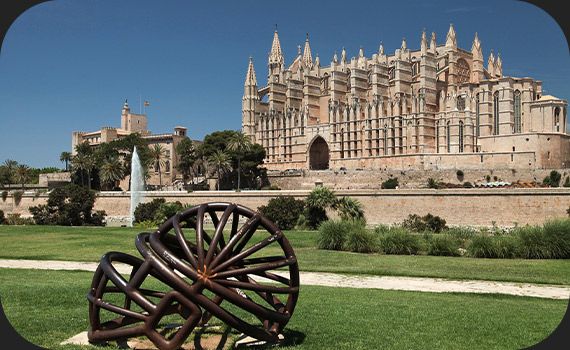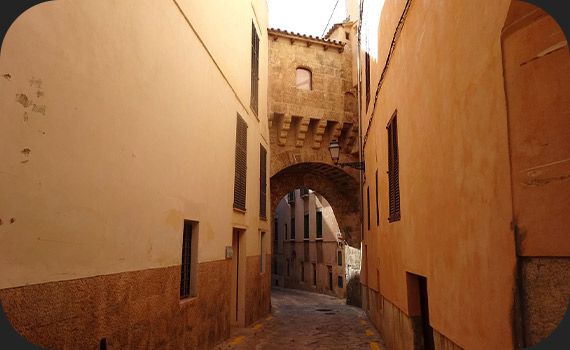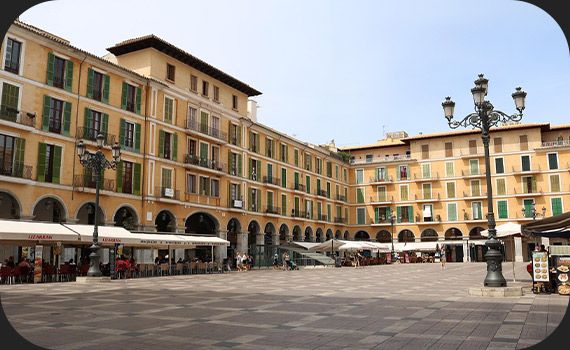
Palma de Mallorca is much more than a coastal city with sun and sand. If you're wondering what to see in Palma de Mallorca, here you'll find history, architecture, charming spots, great food, and a Mediterranean atmosphere that's hard to beat. Whether you're here for a weekend getaway or touring the island, Palma captivates you from the first stroll through its Old Town. In this guide, we'll tell you what to see in Palma de Mallorca, including a selection of must-see spots and some tips to help you make the most of your visit. Put on comfortable shoes, bring water (and sunscreen if it's summer), and explore the city! La Seu isn't just Palma's most iconic building; it's one of those places that leaves you speechless. Its Gothic silhouette rises above the ancient medieval walls overlooking the sea. But the truly spectacular sight is inside: towering columns, one of the largest Gothic rose windows in the world, and a mystical atmosphere thanks to the light that streams in through its stained-glass windows. Furthermore, in the 20th century, Antoni Gaudí left his mark with a restoration that added unique elements, such as the floating altar canopy. If you visit in summer, don't miss the terraces: the views of the historic center, Parc de la Mar, and the Mediterranean Sea are unforgettable. Right next to the Cathedral, you'll find the Royal Palace of Almudaina, a castle with a Moorish soul and a medieval spirit. This building began as a Muslim fortress and was adapted to Christian tastes after the Spanish conquest. Today, it is still used as the official summer residence of the Spanish Royal Family. A tour of its royal halls, courtyards, and terraces will transport you back centuries. As you leave, take the opportunity to lose yourself among the ponds, pergolas, and fountains of the s'Hort del Rei Gardens, reminiscent of Andalusian courtyards. One of the greatest pleasures in Palma is simply strolling through its maze of narrow streets, some barely wider than your shoulders. Here lie true gems: stately homes with their Mallorcan interior patios, quiet, cool, and steeped in history. It's a unique experience that shouldn't be missing from your list of things to see in Palma de Mallorca. Some of the most beautiful streets to see these courtyards are Estudi General, Morey, Portella, and Sol. And if you like modernism, don't miss buildings like Can Forteza Rey or the old Gran Hotel. Next to the old town, the Call Jueu, or Jewish quarter, preserves its original structure. It was home to one of the most important Jewish communities in the Crown of Aragon until it was persecuted and expelled in the 15th century. You can still stroll through its streets with evocative names like Montesión, Seminari Vell, and Torre de l'Amor. There you'll find the Monti-Sion Church, built on the site of a former synagogue. Walking through here is a way to connect with the city's complex and fascinating history. Just 3 kilometers from the city center, on a hill surrounded by forest, stands Bellver Castle, one of the few circular castles in Europe. Built by Jaume II in the 14th century, it served as a residence, a prison, and today houses the city's History Museum. Thanks to its history, architecture, and views, it's a must-see in Palma de Mallorca. From the castle you can see all of Palma: the port, the Serra de Tramuntana mountains... amazing! Located in the historic center, this 15th-century Gothic building was Palma's maritime trading center. Its interior, with helical columns resembling palm trees, is one of the finest examples of civil Gothic architecture in the Mediterranean. It's an ideal photo stop! Located on a quiet side street in the city center are the Arab Baths, one of the few preserved Islamic remains in the city. It's a small but very special place. The main hall has a dome supported by columns recycled from other Roman and Muslim buildings. It's a perfect spot if you're exploring what to see in Palma de Mallorca in one day. The Plaza Mayor is the social heart of the city center. Porticoed and lively, it's surrounded by bars, shops, and artisans. Not far away, in the Plaza de Cort, you'll see the old town hall and a century-old olive tree that has witnessed centuries of history. From here you can continue along streets like Colom or Sant Miquel, full of local shops and bakeries where you can try an authentic ensaimada. This modern art museum is built into Palma's former defensive wall. Inside, you'll find works by Miró, Barceló, Picasso, and other contemporary artists. But even if you don't go inside, the museum's terrace is one of the best viewing points in the city. If you like neighborhoods with a sense of soul, don't miss Santa Catalina. From a fishing district to a trendy area, it maintains its essence with its colorful facades and windmills, but now boasts some of Palma's most interesting restaurants, bars, and shops. Visit its market to see (and taste) local products and enjoy a tapa or a drink on one of its terraces. If you want an experience that combines history, fun, and mystery, Escape The Town is for you. This gamified activity takes you through Palma's most iconic corners while solving puzzles that reveal its history, secrets, and interesting facts. A unique and entertaining way to get to know the city, ideal whether you're traveling alone, as a couple, or with friends.Palma Cathedral

Royal Palace of Almudaina and the Gardens of s'Hort del Rei
Stroll through the old town and discover the Mallorcan patios

The Jewish Quarter: El Call
Bellver Castle
Sa Llotja: jewel of civil Gothic
Arab Baths: hidden corner
Plaza Mayor and Plaza de Cort

It is Baluard
Santa Catalina: the coolest neighborhood
Do you want to discover Palma in a different way?




